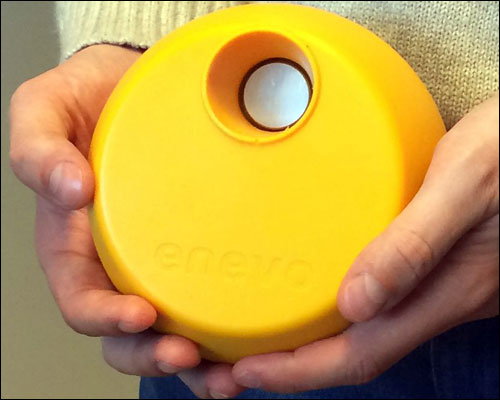In 2010, Fredrik Kekäläinen and Johan Engström, two Finnish telecommunications experts, set out to develop a system to help individuals conserve energy within their homes. Instead, their paths quickly diverted into the waste industry, leading to the creation of a company called Enevo.
“Johan mentioned to Fredrik about the inefficient and expensive waste-management services he was forced to pay at his housing association,” explains Olli Gunst, Enevo’s marketing manager. “This conversation led to the idea of creating smart sensors that optimize waste logistics and make it more efficient.”

Kekäläinen and Engström set about designing an Internet-connected sensor that could be mounted inside a trash bin and monitor its contents. Once it was nearly filled to capacity, the sensors would trigger an alert to the waste hauler, indicating that the bin needed to be emptied. The pair envisioned that this could completely disrupt the conventional trash-collection model, by which trucks empty bins on a set schedule, regardless of whether those bins are full. Plus, it could be used for collecting recyclable and compostable materials as well. It could also mean fuel savings, labor savings and more efficient operations overall, they realized.
In 2012, Enevo announced it had begun a yearlong pilot project with Itä-Uudenmaan Jätehuolto (IUJ), a Finnish waste-management firm that installed Enevo’s sensors in waste bins at 23 collection sites. At the pilot’s conclusion, IUJ had reduced the number of collections it made by 25 percent, while saving anywhere from 15 to 60 percent on monthly operational costs. Based on this result, IUJ signed a multiyear service contract and expanded its Enevo deployment. Enevo has also signed deals with collection companies in Norway, the Czech Republic and Denmark. Paperinkeräys Oy, a recycling service that serves customers in Helsinki, employs Enevo’s technology to manage the collection of cardboard recycling containers throughout the city. Enevo recently raised $8 million in funding from a range of investors throughout the United States, Europe and elsewhere, which it plans to use to expand its business into new markets worldwide.
Here’s how the system works. The Enevo sensing unit contains motion, temperature and ultrasonic sonar sensors. The ultrasonic sensor determines the height of the bin’s contents, relative to the location of the sensor, which is installed just under the lid. This sensor takes a number of measurements, Gunst explains, based on algorithms Enevo has developed for determining the fill-levels in different type of waste containers. “To date,” he says, “our system has been tested in over 140 different container types,” and with more than 30 different kinds of waste, including paper, various types of plastic, compost, oils, metal and textiles.
The temperature sensor triggers alerts only if it detects significant, quick spikes in temperature. This allows the unit to be used in compost bins, the contents of which generate warmth during the decomposition process. Some customers such as recycling companies might want to secure the contents of their collection bins because they are valuable. By setting up an automatic-alert function, customers can ensure that if the Enevo unit detects that movement, they can respond quickly to possible theft.
The ultrasonic sensor scans the bin’s contents to determine fill rate once per hour, while the motion and temperature sensors run all the time. Based on the default settings, the unit has a 10-year battery life—which can be extended if the ultrasonic sensor is set to make less frequent scans when placed within seldom-used bins.
The sensor unit transmits its data via wireless cellular networks to the Enevo servers, where the information is collected, processed and transmitted to the customer’s account dashboard on Enevo’s website. The site displays which bins are nearly full, and also provides predicted fill-up dates, based on the rate at which each bin is filling. In addition, it suggests collection routes, which direct trucks only to the bins that need to be emptied or that have generated alerts. Customers can use this information to make small adjustments to their collection routes. For a more streamlined approach, a customer can use an application programming interface (API), provided by Enevo, to integrate all of the aforementioned data into its enterprise resource planning (ERP) or fleet-management system. Gunst notes that while the majority of existing customers have opted to do this integration, some prefer to use Enevo’s online software in standalone mode, to monitor the condition of collection bins and make tweaks to their collection schedule based on real-time fill data.
Enevo charges a monthly subscription for its services, based on the number of sensor units deployed. According to Gunst, customers report a savings of 20 to 40 percent, thanks to a reduction in fuel consumption and costs related to truck maintenance and labor, due to fewer collections being made.
Smartbin, based in Dublin, Ireland, offers a very similar solution, also employing ultrasonic sensing units installed inside collection bins. The company’s units do not contain a motion sensor but do include a tilt sensor, which can alert a customer if an entire bin has shifted position. Smartbin also offers a mobile version of is software. The firm services a range of industries, including textiles. In the United States, for example, Goodwill Industries of Monocacy Valley, in Maryland, utilizes Smartbin technology to monitor collection bins and trigger its truck fleet to collect only those that are full.

